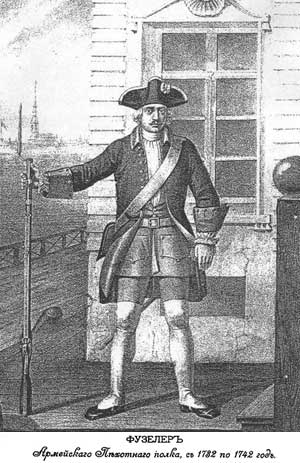
|
|
|
Russian Auxiliary Corps on Austrian service 1734-35 by Vlad Gromoboy Introduction In the beginning of summer 1734 Emperor Karl VI asked Russian Empress Anna to provide 20,000 strong Auxiliary Corps to support Austrians on Rhine. Actions in Poland had already finished & Russian officials didn't have any reasons to maintain large military forces in that country & agreed to send an askable Corps. In September 1734 16 regiments under command of Count Lassy moved to Silesia & stayed there on winter-quarters. In the beginning of the next 1735 Lassy was ordered to move on Rhine with 8 regiments (about 10,000), other 8 stayed in Silesia waiting subsequent orders. Russians marched through Bohemia & Ober Pfaltz & in June arrived on Rhine, where they joined Allied army under Eugene Savoy at Phillipsburg.
Russian Auxiliary Corps Staff Officers General Lassy General-Lieutenant Keith General-Major Bakhmetiev General-Major Karl Biron Fusilier regiments (16) - 2-nd Moscow Since 1731 Fusilier regiment consisted of 2 battalions of 4 companies each, each company was to include 16 grenadiers. The paper wartime strength was 1566(1) (1539 after (2), or about 24,000-25,000 for the 16 regiments.
BO's for Polish campaign 1734 show average field strength of foot regiments in the mid. of June about 600-800 combatants (3). In July-August 1734 Russians might receive reinforcements, also sick & wounded could return to regiments, so I believe each regiment was about 1,200-1,300, incl. 1,000-1,100 combatants. This gives the total strength of the Russian Auxiliary Corps just about asked 20,000.
Uniform Uniform of the Russian infantry in the War of Polish Succession was similar to Great Northern & Seven Year Wars.  Russian fusilier 1732-42 in full equipment from Wiscovatov vol. II N°260 Russian infantry wore dark-green coat with horizontal pockets. Red turn-down collar, round cuffs, lining & facing of the buttonholes. Buttons: 3 on each cuff & flap of the pocket, 2 on bodice, 8 on coat-breast. The coat skirts could be turned back & sewed. Since the end of the 1720-ths on the left shoulder of the coat appeared a colored lace. This was an initiative of regimental commanders for marking their soldiers because of Russian regiments didn't have any regimental distinguishes till the 1760-ths & the color of the lace was chosen by colonels. The tint of coat could be various, from dark-green to the emerald, & this depended on the suppliers. NCOs wore the same uniform as soldiers, but with narrow lace on the borders of collar & cuffs. Corporal had 1 lace, ensigns & fouriers - 2, sergeant - 3. The uniform of the musicians were differed in small "wings" on the shoulder & embroidery. Till the 1734 they were decorated with the lace of the regimental arms color. In summer 1734 new uniform for musicians was adopted, but regiments in Poland continued to wear old coats. New uniform was cut after Prussian one & decorated with colored buttonholes (20) & tassels (28). Their color was chosen by colonels, most often it was red. Long-sleeved vest was red with 18 small buttons. Color of cuffs & small turn-down collar was chosen random, but most often it was also red. In hot weather Russian infantry often wore only vest, without coat. In this situation their color changed from green-red to red & infantry didn't differ from artillery. Soldiers & NCOs wore red trousers, officers - dark-green. Lace-up boots were white & canvas. Epancha (a kind of cloak) was red with red lining. Neckcloth was white. All stab-officers & ranks of the fusilier companies wore black tricorn trimmed with white lace & white rosette/cockade on the left side of tricorn. It played a role of Russian cockade. Grenadiers wore the same uniform as Fusiliers except a headgear & ammunition. In 1731 a new Grenadiers cap was adopted in infantry regiments. It was worn without changes till 1756 & during SYW many grenadiers continued to wear caps of this pattern. This grenadier cap was a green cloth cap with two red flaps. The front flap was decorated with cooper plate with Russian or regimental arms, the rear &emdash; with cooper grenade. Stitches were white, the top of the cap was decorated white tassel. Officers cap was with gold lace & tassel.
Sources: 1 ) Leonov O., Ulianov I., The Regular Infantry, Volume 1 1698-1700, Moscow 1995. 2 ) Maslovskiy D.F., Field & drill service of the Russian army since the Peter the Great till the Empress Elisabeth. The research of the Russian Imperial General Staff. Moscow, 1883. 3 ) Maslovskiy D.F., Attack of Danzig by FM count Minikh in 1734. Collection of relations & orders by count Minikh, St. Peterburg, 190? Wiskovatov, Historical description of the Russian Military uniforms, Vol. II, Vlad Gromoboy  |
||||||||||||||||||||||||||||||||||
|
|
||||||||||||||||||||||||||||||||||